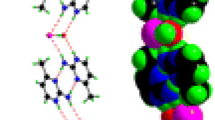Abstract
X-ray diffraction data from single crystals of the trimethylamine complexes of the three boron halides, BCl3, BBr3, and BI3, lead to aP21/m monoclinic cell containing two molecules for each complex. The unit cell dimensions area = 6·68(1),b = 10·247(3),c = 6·502(6) Å, β =116·2(1)° (chloro);a = 6·86(1),b = 10·612(4),c = 6·737(6) Å, β = 115·8(1)° (bromo);a = 6·92(2),b = 10·86(1),c = 7·147(6) Å, β = 93·9(1)° (iodo). The structures were solved by three-dimensional sharpened Patterson functions and show only the chloro and bromo compounds to be isomorphous. Refinement of 662,718 and 954 observed reflexions for the chloro, bromo and iodo complexes, respectively, using anisotropic thermal parameters yielded conventionalR factors of 0·045, 0·087 and 0·054.
The molecules are shown to possess a B—N dative bond, a staggered conformation, and effective 3m (C 3v) symmetry. Average C—N bond lengths are 1·52(1) Å for all three complexes. Boronhalogen bond lengths average 1·864(4), 2·04(2) and 2·28(2) Å, while B—N bond distances are 1·609(6), 1·60(2) and 1·58(3) Å, respectively, for the chloro through iodo compounds. Bond angles are approximately tetrahedral with the C—N—C angle decreasing by several degrees in the Cl → Br → I series.
Similar content being viewed by others
References
Bent, H. A. (1968)Chem. Rev. 68, 587.
Bryan, P. S. & Kuczkowski, R. L. (1971)Inorg. Chem. 10, 200.
Burnham, C. W. (1966)Amer. Mineral. 51, 159.
Busing, W. R. & Levy, H. A. (1964)Acta Crystallogr. 17, 142.
Busing, W. R., Martin, K. O. & Levy, H. A. (1962)ORFLS: A Fortran Crystallographic Least-Squares Program, Publ. ORNL-TM-305 of the Oak Ridge National Laboratory.
Busing, W. R., Martin, K. O. & Levy, H. A. (1964)ORFFE: A Fortran Crystallographic Function and Error Program, Publ. ORNL-TM-306 of the Oak Ridge National Laboratory.
Clippard, P. H. (1969) Dissertation, The University of Michigan.
Cox, H. L., Jr. & Bonham, R. A. (1967)J. Chem. Phys. 47, 2599.
Geller, S. & Hoard, J. L. (1951)Acta Crystallogr. 4, 399.
Hanson, J. R. (1969) Dissertation, The University of Michigan.
Hess, H. (1969)Acta Crystallogr. 25, 2338.
Hughes, E. W. (1941)J. Amer. Chem. Soc. 63, 1737.
Muetterties, E. L. (1960)J. Inorg. Nucl. Chem. 15, 182.
Schilling, J. (1969) Dissertation, The University of Michigan.
Swanson, B., Shriver, D. F. & Ibers, J. A. (1969)Inorg. Chem. 8, 2182.
Author information
Authors and Affiliations
Additional information
Based in part on a dissertation submitted by Patty H. Clippard to the Rackham School of Graduate Studies of the University of Michigan, January 1969 in partial fulfillment of the requirements of the Ph.D. Degree.
Rights and permissions
About this article
Cite this article
Clippard, P.H., Hanson, J.C. & Taylor, R.C. Crystal and molecular structures of three trimethylamine-boron halide adducts: (CH3)3NBCl3, (CH3)3NBBr3, and (CH3)3NBI3 . Journal of Crystal and Molecular Structure 1, 363–371 (1971). https://doi.org/10.1007/BF01201126
Received:
Issue Date:
DOI: https://doi.org/10.1007/BF01201126




